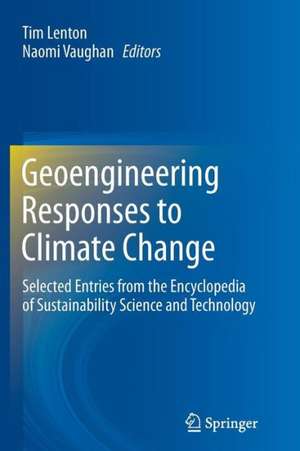Geoengineering Responses to Climate Change: Selected Entries from the Encyclopedia of Sustainability Science and Technology
Editat de Tim Lenton, Naomi Vaughanen Limba Engleză Paperback – 28 ian 2015
| Toate formatele și edițiile | Preț | Express |
|---|---|---|
| Paperback (1) | 635.80 lei 6-8 săpt. | |
| Springer – 28 ian 2015 | 635.80 lei 6-8 săpt. | |
| Hardback (1) | 643.34 lei 6-8 săpt. | |
| Springer – 14 dec 2012 | 643.34 lei 6-8 săpt. |
Preț: 635.80 lei
Preț vechi: 748.00 lei
-15% Nou
Puncte Express: 954
Preț estimativ în valută:
121.68€ • 126.56$ • 100.45£
121.68€ • 126.56$ • 100.45£
Carte tipărită la comandă
Livrare economică 14-28 aprilie
Preluare comenzi: 021 569.72.76
Specificații
ISBN-13: 9781489999641
ISBN-10: 1489999647
Pagini: 204
Ilustrații: V, 199 p.
Dimensiuni: 155 x 235 x 11 mm
Greutate: 0.29 kg
Ediția:2013
Editura: Springer
Colecția Springer
Locul publicării:New York, NY, United States
ISBN-10: 1489999647
Pagini: 204
Ilustrații: V, 199 p.
Dimensiuni: 155 x 235 x 11 mm
Greutate: 0.29 kg
Ediția:2013
Editura: Springer
Colecția Springer
Locul publicării:New York, NY, United States
Public țintă
Upper undergraduateCuprins
1. Introduction.- 2. Sunshades for Solar Radiation Management.- 3. Stratospheric Aerosols for Solar Radiation Management.- 4. Solar Radiation Management, Cloud Albedo Enhancement.- 5. Ocean Fertilization for Sequestration of Carbon Dioxide from the Atmosphere.- 6. Biochar, Tool for Climate Change Mitigation and Soil Management.- 7. Carbon Dioxide Sequestration, Weathering Approaches to.- 8. Geoengineering Policy and Governance Issues.- Index.
Textul de pe ultima copertă
Failure by the international community to make substantive progress in reducing CO2 emissions, coupled with recent evidence of accelerating climate change, has brought increasing urgency to the search for additional remediation approaches. This book presents a selection of state-of-the-art geoengineering methods for deliberately reducing the effects of anthropogenic climate change, either by actively removing greenhouse gases from the atmosphere or by decreasing the amount of sunlight absorbed at the Earth’s surface. These methods contrast with more conventional mitigation approaches which focus on reducing emissions of greenhouse gases, especially carbon dioxide. Geoengineering technologies could become a key tool to be used in conjunction with emissions reduction to limit the magnitude of climate change. Featuring authoritative, peer-reviewed entries from the Encyclopedia of Sustainability Science and Technology, this book presents a wide range of climate change remediation technologies.
Examines the potential of geoengineering technologies to contribute to the goal of restricting global warming to within 2°C of preindustrial levels
Discusses carbon dioxide removal (CDR) and solar radiation management (SDR)
Places the technologies discussed in their proper social, political, and ethical contexts
Provides valuable insights for audiences ranging from researchers and industry experts to policy makers and university-level students
Examines the potential of geoengineering technologies to contribute to the goal of restricting global warming to within 2°C of preindustrial levels
Discusses carbon dioxide removal (CDR) and solar radiation management (SDR)
Places the technologies discussed in their proper social, political, and ethical contexts
Provides valuable insights for audiences ranging from researchers and industry experts to policy makers and university-level students
Caracteristici
Examines the potential of geoengineering technologies to contribute to the goal of restricting global warming to within 2°C of preindustrial levels Discusses carbon dioxide removal (CDR) and solar radiation management (SDR) Places the technologies discussed in their proper social, political, and ethical contexts Provides valuable insights for audiences ranging from researchers and industry experts to policy makers and university-level students












